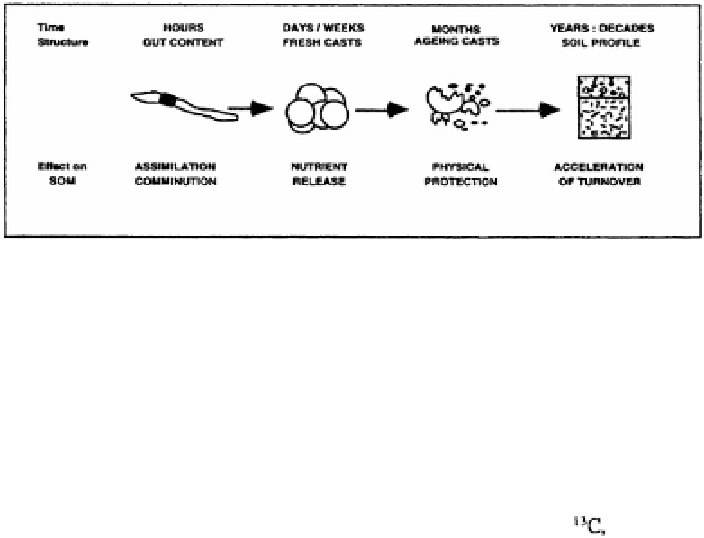Agriculture Reference
In-Depth Information
The effects of 'compacting species' may also depend on factors operating at larger
scales of time and space, notably organic matter supply and the types and abundances of
the different clay materials present. In a three-year field experiment conducted in
Peruvian Amazonia, the earthworm
Pontoscolex corethrurus
was introduced into the soil
of an annual cropping system with significant positive effects on plant production, and
evidence of soil compaction in some treatments (Alegre
et al.,
1996). Compaction only
occurred in treatments with no organic inputs; in these, earthworms produced casts
of low structural stability which dispersed to form a compact, continuous surface crust.
In contrast, in soil treatments where stubble mulch and legume green manure were
applied, casts retained a solid structure and the soil of the upper 4 cm had a large
proportion of macropores and macro-aggregates, with much better conditions for
infiltration (Duboisset, 1995).
Regulation of SOM dynamics
Endogeic earthworm populations in soils of the humid tropics have been shown to exert
a significant role on SOM dynamics at different scales of time and space (Martin, 1991;
Lavelle
et al.,
1998)(Figure IV.56).
In the short term.
Earthworm activity results in the assimilation of a relatively small
proportion of SOM, ranging from 2-6 % to a maximum of 18 % (Martin
et al.,
1990;
Barois
et al.,
1987). Clear changes in the distribution of SOM between particle size
fractions have also been found following digestion by the endogeic earthworm
Millsonia
anomala
: that in the coarse fractions decreased sharply (
e.g.,
25
%
in the
fraction) while SOM in the finer fractions tended to increase. Similar changes were noted
with
Polypheretima elongata
in a Martiniquan vertisol (Figure IV.53). By selectively
feeding worms with particle size fractions naturally labelled with Martin
et al.
(1991) demonstrated that this effect was largely due to comminution as all particle-size
fractions were equally digested under the conditions of her experiments.
Medium-term effects.
Mineralisation of SOM decreases sharply in casts of the compact-
ing species
Millsonia anomala
and stabilises at a minimum level after a few days. As a
result, the SOM contents of casts remained higher than values measured in a 2 mm-



